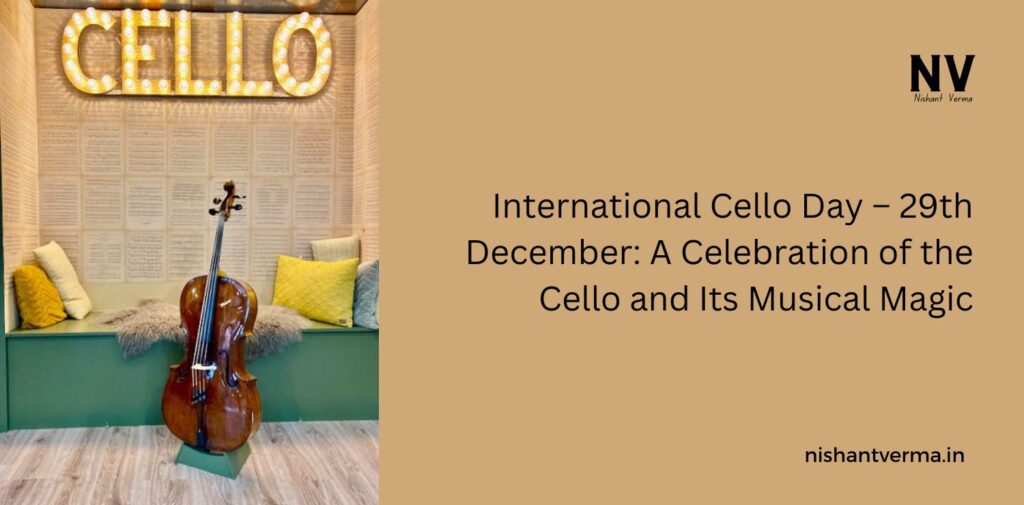Music has a universal language that speaks to our hearts, transcending borders, cultures, and languages. Among the many instruments that make up this vast musical world, the cello holds a special place. With its deep, resonant tones and rich, emotional range, the cello has the power to evoke profound feelings, whether it’s playing a dramatic concerto or a soft, melodic piece. To honor this incredible instrument, International Cello Day is celebrated every year on 29th December. This special day is an opportunity for music lovers around the world to recognize and appreciate the beauty of the cello.
The Cello: A Brief Introduction
The cello, a member of the string family, is one of the largest and most expressive instruments in an orchestra. It has four strings, and it is typically played while seated, with the instrument held between the knees. The sound produced by the cello is rich and warm, ranging from low, earthy tones to high, sweet melodies. The cello’s ability to mimic the human voice is one of the reasons why it is loved by musicians and listeners alike.
While the cello has been around for centuries, its significance in classical and modern music continues to grow. From being part of grand symphonies to taking the spotlight in solo performances, the cello can be found in a variety of musical settings. It is featured in compositions by famous composers like Ludwig van Beethoven, Johannes Brahms, and more recently, film scores, where it adds depth and emotion to the soundtrack.
The History of the Cello
The cello originated in the early 16th century, evolving from earlier instruments like the viola da gamba. Initially, it was used mostly in the Baroque and Classical periods in Europe, but over time, composers began to realize its full potential for expression. It became a central instrument in orchestral and chamber music. The cello’s history is rich, and it has evolved with changes in music, culture, and technology. Today, modern cellos are made from fine woods like spruce and maple, and they are meticulously crafted to produce the best sound.
In India, while the cello may not be as widely recognized as the sitar or tabla, it has been gaining recognition in recent years. With the growing interest in Western classical music and fusion genres, many Indian musicians are incorporating the cello into their performances. The cello’s versatility makes it a perfect match for both Western and Indian music, leading to innovative collaborations.

International Cello Day: A Global Celebration
International Cello Day, observed on 29th December each year, is a celebration of the cello and its place in the world of music. It is a day when cello players, music lovers, and enthusiasts come together to celebrate this beautiful instrument. The day is marked by events such as concerts, workshops, and performances, where cellists from all over the world showcase their talent. Whether it’s a professional concert or an informal gathering, International Cello Day is a moment to appreciate the cello and its contribution to music.
International Cello Day also helps raise awareness about the importance of music education and the role of instruments like the cello in nurturing young talent. It encourages people of all ages to learn music and explore their creative abilities. Schools, music institutions, and conservatories often take part in celebrations, organizing special programs to introduce students to the cello and its unique sound.
The Role of the Cello in Indian Music
India has a rich and diverse musical heritage, with classical music playing an integral part in the culture. Indian classical music is traditionally built on instruments like the sitar, tabla, and flute. However, with the influence of Western music, there has been a growing appreciation for the cello and its role in Indian music.
Indian musicians have started to experiment with the cello, blending it with traditional Indian instruments and melodies. The cello’s ability to convey emotion and mimic the human voice makes it a perfect addition to Indian music. In films, the cello has become a part of the orchestra, adding a sense of grandeur and emotion to soundtracks. Bollywood composers, for instance, have used the cello in many songs to evoke powerful emotions, whether it’s in romantic tracks or dramatic moments.
In addition, Indian classical music has seen the emergence of cellists who are trained in both Western and Indian music. These musicians blend classical Western techniques with Indian ragas, creating a fusion of two musical worlds. This unique combination has led to innovative compositions and performances that have captured the attention of audiences worldwide.

Celebrating International Cello Day in India
International Cello Day offers a wonderful opportunity for Indian audiences to connect with this magnificent instrument. Music festivals and events in cities like Mumbai, Delhi, Bangalore, and Chennai may feature performances by renowned cellists. These performances can offer an introduction to the cello for those who may not be familiar with it, while also providing a deeper experience for those already passionate about the instrument.
For aspiring musicians in India, International Cello Day can be a source of inspiration. The cello may seem like an intimidating instrument to start with, but with dedication and practice, it can be mastered just like any other. On this day, many music schools may offer discounts on cello lessons or host introductory sessions, encouraging young learners to pick up the instrument.
Moreover, social media platforms are an excellent way to celebrate International Cello Day. Many cellists and music enthusiasts share videos of their performances, discuss cello techniques, and post inspirational stories. The day can also be a time for music lovers to discover new cello artists or explore their favorite cello pieces.

The Emotional Power of the Cello
One of the key reasons the cello is celebrated on International Cello Day is because of its incredible emotional range. The cello has the unique ability to touch listeners in a way few instruments can. Its deep, soulful sound can evoke feelings of sadness, joy, nostalgia, or triumph. Whether it’s playing the intense and dramatic notes of a classical concerto or the gentle, comforting melodies in a movie soundtrack, the cello always has the ability to connect with its audience on an emotional level.
For music lovers in India, the cello offers an exciting musical journey. It invites listeners to appreciate the nuances of sound and the deep emotions that come with it. The cello teaches us that music, at its core, is not just about notes and rhythms but about feelings and stories shared through sound.
Conclusion
International Cello Day on 29th December is not just a celebration of the cello as an instrument, but also a celebration of music’s power to connect people and cultures. For Indian audiences, it is an opportunity to explore and embrace a beautiful instrument that has enriched classical and contemporary music around the world. Whether you are a cellist, a listener, or a music lover, International Cello Day is a perfect occasion to appreciate the cello and the magic it brings to music. It reminds us that music is a language that unites us all, and the cello is one of the most powerful voices in that language.




